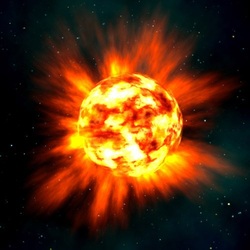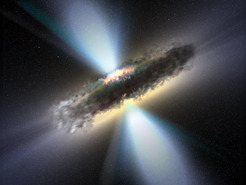How Super Giants Die:
A star with a mass much greater than that of the sun will form, live, and die more quickly than a main sequence star. The reason for this is its greater mass, for the resulting gravity squeezes the star's core and creates greater pressures, resulting in a faster fusion rate.
The reason Antares glows red is that since its outer layers have expanded, it has a much greater volume to heat, yet is only producing the same amount of energy. Thus, it is naturally cooler, and glows red.
The difference at this point between a super giant and a main sequence star is that a super giant has the pressures needed to fuse carbon into iron. However, this fusion process takes energy, rather than gives it. So, as energy is lost, the star no longer possesses the balance between outward pressure and gravity pushing in. As a result, gravity wins, and the core collapses in a violent explosion called a supernova.
Because of the extreme mass of Antares after it goes supernova, the star will continue to collapse into a black hole.
The reason Antares glows red is that since its outer layers have expanded, it has a much greater volume to heat, yet is only producing the same amount of energy. Thus, it is naturally cooler, and glows red.
The difference at this point between a super giant and a main sequence star is that a super giant has the pressures needed to fuse carbon into iron. However, this fusion process takes energy, rather than gives it. So, as energy is lost, the star no longer possesses the balance between outward pressure and gravity pushing in. As a result, gravity wins, and the core collapses in a violent explosion called a supernova.
Because of the extreme mass of Antares after it goes supernova, the star will continue to collapse into a black hole.
How a star of an opposite mass will die (Low Mass):
A low mass star will have a much less extravagant death then a high mass star. Instead of going supernova or creating a black hole, a low mass star will simply burnout. As the star uses up its hydrogen fuel it begins to collapse. The star is unable to fuse helium since it does not have enough pressure at its core. It then continues to collapse and cool until it becomes a small dim black dwarf.




